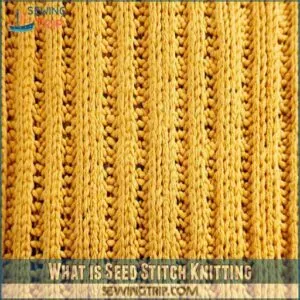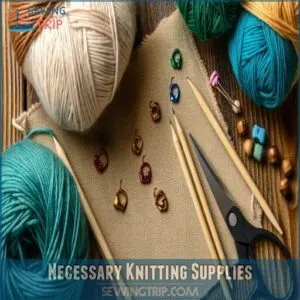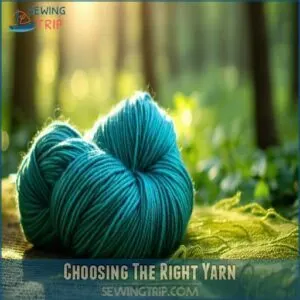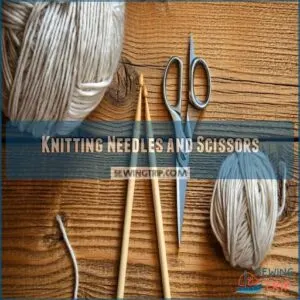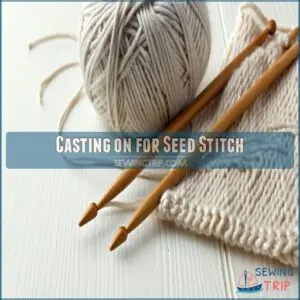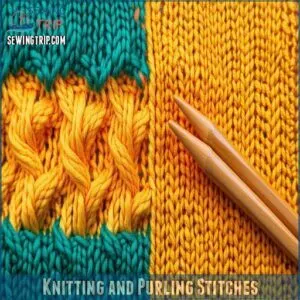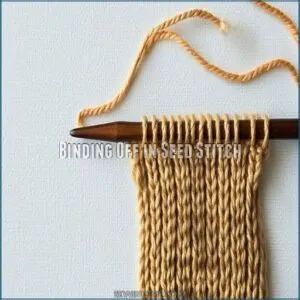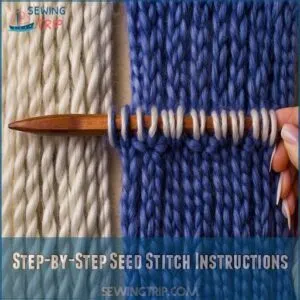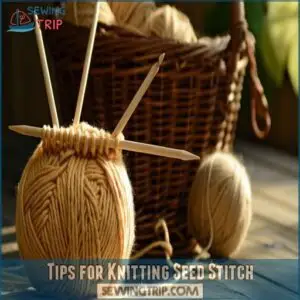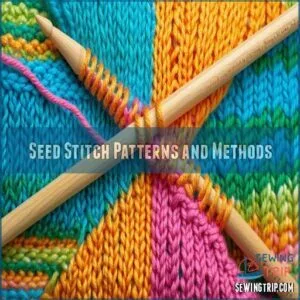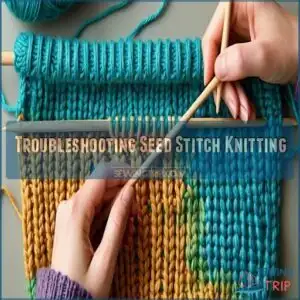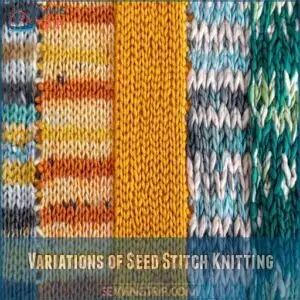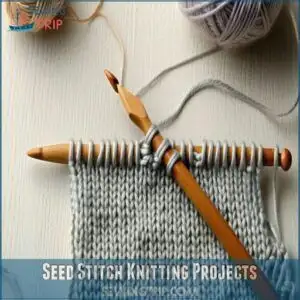This site is supported by our readers. We may earn a commission, at no cost to you, if you purchase through links.
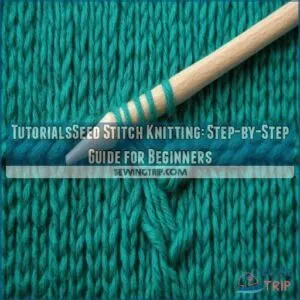
Known also as moss stitch, this technique is perfect for beginners since it doesn’t curl up and looks great on both sides.
All you need are some knitting needles, yarn, and a few basic skills like casting on, knitting, and purling.
Simply alternate between knit and purl stitches to create a bumpy fabric that adds flair to scarves, hats, or blankets.
Watch out for dropped stitches, though—they’re sneaky!
As you master this technique, discover handy tips and tricks that’ll keep your projects smooth sailing.
Table Of Contents
- Key Takeaways
- What is Seed Stitch Knitting
- Supplies for Knitting Seed Stitch
- Knitting Techniques to Know
- Step-by-Step Seed Stitch Instructions
- Tips for Knitting Seed Stitch
- Seed Stitch Patterns and Methods
- Troubleshooting Seed Stitch Knitting
- Variations of Seed Stitch Knitting
- Seed Stitch Knitting Projects
- Frequently Asked Questions (FAQs)
- Conclusion
Key Takeaways
- You’ll find seed stitch perfect for beginners; it doesn’t curl and has a delightful, bumpy texture that’s reversible, adding flair to scarves and hats.
- To knit seed stitch, alternate between knit and purl stitches, maintaining even tension to avoid accidental yarn overs and dropped stitches.
- Explore variations like seed stitch in the round and oblique seed stitch for added texture and creative projects like blankets and sweaters.
- You can easily adapt existing patterns into seed stitch by swapping knit stitches for purl stitches and vice versa, creating a unique nubby design.
What is Seed Stitch Knitting
Seed stitch knitting creates a delightful, bumpy texture that’s almost as fun to say as it’s to knit, making your project look both unique and cozy.
Seed stitch is also known as British moss stitch.
It lies flat, doesn’t curl, and is a beginner’s favorite for adding texture without too much fuss.
Definition and Texture
Ever tried squeezing an acorn? That’s kinda what seed stitch feels like—textured and bumpy, yet somehow smooth.
Seed stitch offers:
- Textures galore: Perfect for coziness.
- Reversible magic: No right or wrong side.
- Versatility: Lies flat without curling.
You’ll alternate knit and purl stitches, creating a nubby, timeless pattern that’s like a cozy sweater hug, ready to keep everything interesting!
Other Names for Seed Stitch
Seed stitch, with its unique textured charm, isn’t just called by one name.
You might hear it referred to as British moss stitch or even plain old moss stitch.
These names capture its charming bumpy, textured knitting look, perfect for those who appreciate versatility.
So next time you’re chatting with your knitting pals, you can showcase your know-how with these handy terms!
Qualities of Seed Stitch
Getting into the groove of seed stitch, you’ll find it has some fantastic qualities.
This textured knitting pattern is beginner-friendly and easy to learn, offering a reversible fabric that looks great on both sides.
Thanks to its nubby texture, it lies flat, making it perfect for borders and edges.
With alternating knit and purl stitches, it’s all about creating a cozy, uniform look.
Supplies for Knitting Seed Stitch
To start your seed stitch adventure, gather some yarn, a pair of knitting needles, scissors, and a tapestry needle.
Don’t worry about fancy gear; these trusty basics will do the trick, unless your cat claims the yarn for playtime!
Necessary Knitting Supplies
Before you begin your seed stitch adventure, gather your knitting supplies!
You’ll need yarn, of course, along with a pair of knitting needles—the size depends on your yarn weight and project type.
To prevent edges from curling and add visual appeal, consider learning the seed stitch basics.
Don’t forget stitch markers, a tapestry needle for weaving in ends, and some trusty scissors.
These tools are your trusty sidekicks for this project.
Happy knitting!
Choosing The Right Yarn
You’ve gathered your supplies, so now let’s pick the right yarn.
Think about yarn weight and fiber content—it’s like finding your knitting soul mate.
Lighter yarns can show off the seed stitch texture beautifully, giving it that pop.
Look at color choices too; bold colors transform a simple stitch into a statement piece.
Make sure the yarn matches your project needs.
Knitting Needles and Scissors
Picking the right knitting needles is like finding the perfect dance partner.
You’ll want to match needle sizes and materials with your yarn for smooth moves.
Wooden or bamboo needles might just be your groove if you’re into gentle guidance.
And for choosing scissors, sharp and comfy types are your best bet.
Keep your tools sharp and tidy for easy stitching fun!
Knitting Techniques to Know
Mastering the basics like casting on, knitting, purling, and binding off is all you need to get started with seed stitch.
Don’t worry if your stitches look a bit wobbly at first—practice makes perfect, and soon you’ll be stitching like a pro!
Casting on for Seed Stitch
Casting on is your first step to mastering seed stitch, which is a beginner-friendly stitch that creates a textured fabric resembling scattered grains, as seen in tutorials on seed stitch knitting.
Try the long-tail cast-on for a sturdy start—it’s like a trusty friend that’s always there.
If you’re feeling adventurous, go for the continental cast-on or even the cable cast-on.
Each method sets the stage beautifully for your knitting journey.
So grab those needles, and let’s begin this exciting adventure into knitting!
Knitting and Purling Stitches
Imagine the satisfying rhythm of knitting and purling stitches brings your seed stitch to life.
Keep your stitch tension even, adjusting needle size and yarn weight if needed.
With a balanced stitch count and row gauge, you’ll soon master knitting stitches like a pro.
Remember, alternate between the knit stitch and the purl stitch to create that charming, nubby texture.
Binding Off in Seed Stitch
Binding off in seed stitch could be your project’s grand finale.
It’s all about finishing those red-carpet edge details with flair.
Here’s how you do it:
- Begin by knitting or purling two stitches.
- Lift the first stitch over the second, letting it fly off like a superhero.
- Continue, binding off each next stitch in pattern, ensuring your edges shine!
Step-by-Step Seed Stitch Instructions
Ready to create your first seed stitch masterpiece?
We’ll walk you through knitting this awesome texture stitch, step by step, so don’t worry if you’ve never done it before—you’ve got this!
Knitting Seed Stitch in Rows
Once you’ve got your yarn and needles ready, you’re all set to knit seed stitch in rows!
Imagine a cozy evening, knitting away with this brilliant stitch. Start with an odd number of stitches.
| Row | Action | Result |
|---|---|---|
| 1 | K1, P1 | Nubby texture |
| 2 | P1, K1 | Reversible fabric |
| 3 | K1, P1 | Flat and neat |
| 4 | P1, K1 | No curling edges |
| 5 | Repeat | Perfect seed stitch |
This pattern helps stabilize your row gauge, resulting in a perfect seed stitch texture!
Knitting Seed Stitch in Rounds
You’ve mastered seed stitch in rows, and now it’s time to tackle rounds.
Grab your circular needles and start knitting with the help of a circular seed stitch guide, which can be found at Circular Seed Stitch Resources.
Begin with "K1, p1" around, remembering, like a rhythm, to knit the purls and purl the knits.
It’s like a dance between your needles and yarn.
Enjoy creating cozy seed stitch hats, unique socks, or whatever strikes your fancy!
Seed Stitch for Odd and Even Numbers
When knitting seed stitch, you’re either dealing with odd or even numbers, like picking between apple and orange slices—both tasty, but handled differently.
- Odd Numbers: Repeat K1, P1 across each row.
- Even Numbers: Alternate rows with K1, P1, then P1, K1.
- Mind the Tension: Keep stitches loose.
- Pattern Adjustments: Adapt for desired texture.
Happy knitting!
Tips for Knitting Seed Stitch
When you’re getting into seed stitch knitting, a few helpful tips can make your journey smoother.
like maintaining even tension and steering clear of accidental yarn overs, which are as sneaky as they sound.
By keeping an eye on these potential pitfalls and practicing consistently, you’ll soon master this versatile and classic stitch, impressing even your cat with the results!
Maintaining Even Tension
In seed stitch knitting, achieving even tension can feel like taming a wild horse. Uneven tension turns stitches into a rollercoaster ride.
| Common Issues | Cause | Solution |
|---|---|---|
| Tension too loose | Large needle size | Use smaller needles |
| Tension too tight | Small yarn weight | Try a heavier yarn |
| Inconsistent tension | Hasty stitch formation | Slow down, practice drills |
Practice makes perfect, and soon you’ll knit smoothly!
Avoiding Accidental Yarn Overs
Keeping even tension is key.
They can sneak in like surprise guests at a party. To avoid them, always move the yarn to the back before knitting, and to the front before purling.
This simple trick helps maintain stitch consistency. It’s like giving those stitches a friendly nudge to behave and stay put! pesky accidental yarn overs To avoid them
Common Seed Stitch Mistakes
Having a few seed stitch snafus? Don’t worry, it happens to the best of us!
Dropped stitches? Uneven rows? A wrong stitch count? These are common seed stitch knitting mistakes.
When troubleshooting, consider if your issues might be similar to those encountered in sewing, such as improper thread tension.
Remember to maintain even tension to avoid those pesky yarn overs.
Double-check your stitch count regularly, and if you spot a mistake, gently frog back to correct it.
You’ve got this!
Seed Stitch Patterns and Methods
You’re about to explore different seed stitch knitting methods, each with its own twist—like the classic method that keeps you on track or the hack method that lets you wing it a bit.
These techniques, including knitting in the round, give you the freedom to create gorgeous, textured patterns while keeping things fun and manageable.
Classic Method for Seed Stitch
Diving into the classic method for seed stitch, let’s unravel its charm!
Known for its simplicity, the classic method makes for even tension and elegant texture.
Follow these steps:
- Cast on an odd number of stitches for balance.
- Knit 1, purl 1 across; repeat to maintain design.
- Adjust row count for pattern length.
- Avoid fluff by keeping stitch count snug.
Hack Method for Seed Stitch
The classic seed stitch gives structure, but the hack method’s like finding a shortcut on your school route.
Whether you’ve cast on even or odd rows, just knit the purls and purl the knits.
It’s simple and intuitive, letting you embrace the rhythm of any yarn you’ve got handy.
These seed stitch variations turn mistakes into a seamless adventure!
Seed Stitch in The Round Patterns
With your hack method skills, you’re ready to tackle round seed stitch.
Grab those circular needles and let’s craft some texture-rich hats or cozy scarves that wrap up in style.
For blankets, you’ll love how this pattern works seamlessly in the round, knitting and purling as usual.
It’s like a knitting dance—round and round you go, mastering the seed stitch pattern effortlessly.
Troubleshooting Seed Stitch Knitting
When your seed stitch turns into ribbing and you find mysterious holes appearing, don’t worry—you’re not alone in this knitting puzzle!
With a few common fixes and handy tips, you’ll untangle those knots and add a fun twist to your knitting journey.
Why Seed Stitch Turns Into Ribbing
Sure, spotting why your seed stitch turned into ribbing can feel like hunting for a lost sock.
It usually happens for these reasons:
- Stitch tension: Keeping consistent tension’s key, or your stitches will dance into ribbing.
- Pattern errors: It’s easy to slip up and switch your knits and purls.
- Beginner mistakes: Everyone mixes them at first, you’re not alone!
Fixing Common Seed Stitch Errors
So, your seed stitch morphed into ribbing? Don’t sweat it!
Fixing dropped stitches is easy—just gently weave them back in.
Uneven tension? Try counting stitches and rows.
See holes? You likely had an accidental yarn over.
Practice makes perfect! This seed stitch knitting tutorial will help you master the knit and purl. Happy knitting!
Seed Stitch Knitting Troubleshooting Tips
Knitting seed stitch can resemble a walk down a bumpy path sometimes. But fixing common errors is easier when you know what to look for.
Troubleshoot your knitting with these handy tips:
- Watch out for dropped stitches.
- Keep an eye on uneven tension.
- Repair holes promptly.
- Check your gauge regularly.
- Don’t let pattern errors trip you up.
Stay patient, and remember: even small mistakes can lead to better skills!
Variations of Seed Stitch Knitting
You’re about to explore the fun world of seed stitch variations.
where simple tweaks can make your knitting pop with unique textures.
Whether it’s trying oblique seed stitch or debating moss stitch versus seed stitch, there’s always something new to learn and enjoy!
Simple Seed Stitch Variations
While you may think knitting basics can’t be exciting, seed stitch variations prove otherwise.
Explore colorful combinations with colorwork seed stitch or add dimension with textured seed stitch.
Mix it up with cables & seed or go delicate with lace & seed.
Imagine seed stitch stripes in your projects, offering creative flair and endless opportunities for all knitting tutorials to explore.
Oblique Seed Stitch Knitting
Tired of the usual seed stitch? Oblique variations add a twist with a diagonal texture. It’s perfect for those who love a fresh challenge in their knitting projects.
For more inspiration, explore oblique seed stitch patterns and products online at oblique seed stitch resources.
Here’s how you can switch it up:
- Play with knit and purl stitches for diagonal textures.
- Experiment with different yarn weights for unique effects.
- Try small projects like coasters or dishcloths before tackling bigger ones.
Moss Stitch Vs Seed Stitch
Just finished exploring oblique seed stitch? Awesome! Now, on to moss stitch!
You might wonder, what’s the big difference between moss stitch and seed stitch?
Both add terrific texture and look quite similar.
However, while you knit seed stitch with one round of knit, purl, repeat, moss stitch doubles the rows before switching.
Both use knit and purl stitches, offering versatile uses.
Seed Stitch Knitting Projects
Whether you’re cozying up with a new scarf or tackling a comfy sweater, seed stitch is your ticket to stylish knitting projects.
Seed stitch is your ticket to stylish knitting projects.
Grab your needles and get ready to create everything from hats to blankets, with lots of texture and maybe even a bit of bragging rights!
Scarf and Sweater Patterns
Ready to knit something amazing? Seed stitch scarves are a fantastic starting point!
Tons of free seed stitch scarf designs are online for beginners.
Experiment with seed stitch colorwork; it’s easier than you think!
When choosing a pattern for a cozy sweater, look for designs with clear instructions and basic stitches like seed stitch, as suggested in the guide to sew a cozy sweater beginner.
For sweaters, consider simple sweater stitch combinations using seed stitch.
Remember yarn weight considerations—thicker yarn knits up faster.
Let’s knit!
Hats and Blankets With Seed Stitch
Picture yourself wrapped in a cozy seed stitch blanket, each nubby purl and knit adding delightful texture.
Seed stitch hat patterns range from simple to intricate, embracing warmth with each row.
Experiment with blanket stitch variations and play with yarn choices for blankets that truly pop.
Explore seed stitch colorwork, creating hats and blankets that reflect your colorful creativity in every stitch.
What Can I Make With Seed Stitch Knitting
When you’re armed with seed stitch skills, you’ve got a world of knitting projects at your fingertips.
Think cozy blankets, stylish scarves, snug hats, and trendy cowls.
Even baby booties and cozy sweaters can shine with this versatile stitch.
Whether you’re crafting unique gifts or adding to your wardrobe, seed stitch knitting keeps it fresh and engaging, perfect for all your creative endeavors.
Frequently Asked Questions (FAQs)
How do you knit seed stitch?
To knit seed stitch, cast on an odd number of stitches.
Alternate knit and purl stitches across the row.
For the next row, knit the purls and purl the knits.
It’s like creating a dance between stitches!
How to knit seed stitch flat & in the round?
Did you know seed stitch is super popular? Knitting it flat? K1, P1, repeat! In the round? Same deal, but in circles. You got this!
What is seed stitch knitting?
Seed stitch knitting gives your projects a delightful, bumpy texture that’s perfect for scarves and blankets.
You simply alternate between knit and purl stitches.
This stitch is great for beginners and adds a unique touch to any piece.
Can you knit seed stitch without a pattern?
Knitting seed stitch without a pattern is as easy as pie!
You simply alternate knitting and purling stitches, making every row or round a delightful weave of texture.
Keep the rhythm, and you won’t need a guide.
Can you convert a knitting pattern into seed stitch?
Just swap all knit stitches for purl stitches and vice versa in your pattern.
This simple change transforms any knitting pattern into that lovely, nubby seed stitch texture.
It’s a fun, rewarding twist!
Is seed stitch easy to learn?
You’ll find seed stitch simple to pick up, even if you’re new to knitting.
Its basic knit and purl pattern adds charming texture, doesn’t curl, and is forgiving.
Think of it like baking bread—hands-on but rewarding!
How to knit the seed stitch for beginners?
Imagine juggling a few yarn balls — that’s how seed stitch works: alternate knitting and purling to create a bumpy, delightful texture.
Cast on stitches, then just knit the purls, purl the knits, and repeat.
What is a simple seed stitch?
Seed stitch is a simple, beginner-friendly knitting pattern that alternates knit and purl stitches.
It’s easy to learn: just knit the purls and purl the knits.
The texture resembles bumpy seeds, adding charm to any project.
What is the difference between seed stitch and ribbing?
Think of it like this: ribbing’s stripes are stacked neatly, while seed stitch’s are playfully intertwined. One’s a structured march, the other a happy dance of knits and purls!
What is the formula for seed stitch?
To create seed stitch, use the formula: alternate knit and purl stitches across rows.
For odd rows, start with knit; reverse on even rows.
In rounds, simply alternate by knitting purls and purling knits continuously.
Conclusion
Did you know that seed stitch is one of the top ten favorite patterns for beginner knitters?
Now you can take pride in adding this versatile texture to your knitting repertoire.
With this TutorialsSeed Stitch Knitting guide, you’ll confidently tackle projects like cozy scarves or stylish hats.
Remember, each knit and purl stitch is a step toward mastering this classic method.
So grab your needles, ignite your creativity, and watch your projects come to life!

